Exploring the Multifaceted Benefits of Lavender

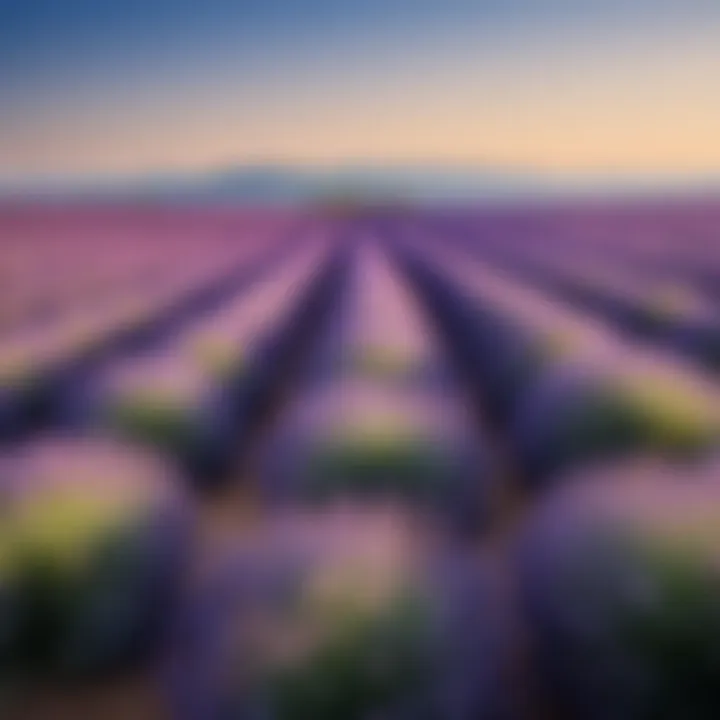
Intro
Lavender has held a special place in various cultures for centuries, revered for its fragrance and therapeutic properties. Beyond its enticing scent, this plant offers a treasure trove of benefits that can enhance both physical and emotional well-being. Whether it’s used in aromatherapy, skincare, or natural remedies, understanding lavender’s multifaceted uses can empower individuals to make informed choices about their health and beauty routines. This article dives into the heart of lavender’s benefits, unraveling its uses with precision and depth, and providing a thorough guide for anyone looking to incorporate this stunning herb into their lives.
Ürün İncelemesi
Ürün Tanıtımı
Lavender, scientifically known as Lavandula angustifolia, is a perennial herb native to the Mediterranean regions. It’s characterized by its tall, thin stems topped with purple flowers that emit a soothing aroma. The essential oil derived from these flowers is a staple in various wellness practices. Known for its calming effects, lavender oil is often used in diffusers, massage oils, and bath products. This plant also finds its way into culinary dishes, enriching flavors and offering health benefits. From food to focused meditation, lavender’s versatility makes it a remarkable addition to many facets of life.
Ürün Özellikleri
Lavender is lauded for its myriad properties, some of which include:
- Anxiolytic Effects: Its soothing aroma helps alleviate anxiety and stress, making it a favored choice in aromatherapy.
- Antiseptic Qualities: Lavender oil has natural antiseptic properties, beneficial for minor cuts or bruises. It aids in the healing process while also preventing bacterial infections.
- Versatile Use: Beyond relaxation, lavender can be infused into oils, used in food, and even added to homemade beauty products, showcasing its adaptability.
"Lavender is more than just a pretty flower; it’s a versatile ally that promotes wellness and beauty in numerous forms."
Güzellik İpuçları
Doğal Güzellik Yöntemleri
Many have turned to lavender for beauty routines that harness its natural elegance. Its essential oil is famed for promoting clear skin by soothing irritations and reducing redness. Here are a few wonderful ways to utilize lavender in beauty:
- Facial Steam: Adding a few drops of lavender oil to hot water can create a delightful facial steam that opens pores and rejuvenates skin.
- Lavender Lotion: Mixing lavender essential oil with a carrier oil creates a hydrating lotion, perfect for dry skin.
- Hair Care: Lavender oil can be infused in shampoos to promote healthier hair, combating dandruff and dermatitis on the scalp.
Sağlıklı Beslenme ve Güzellik
Lavender also transcends its aromatic properties into culinary delights. Incorporating lavender into your diet can be both delicious and beneficial:
- Herbal Tea: A soothing lavender tea helps in relaxation and can aid digestion.
- Culinary Herb: Infusing dishes with dried lavender buds imparts a unique flavor and aids in digestion.
- Gourmet Desserts: Lavender can enhance desserts like cookies or ice cream, transforming them into something extraordinary while providing calming effects.
With its broad spectrum of benefits, lavender offers a unique opportunity to enrich both life and beauty, striking a balance between holistic wellness and natural allure. By understanding its multifaceted uses, one can truly harness the power of lavender in everyday life.
Preface to Lavender
Lavender, with its delicate purple blooms and soothing aroma, has been a beloved plant for centuries. Its significance goes beyond mere aesthetics; lavender's multifaceted benefits have earned it a prominent place in various domains, including wellness, beauty, and even culinary traditions. In an age where stress levels are often high and the search for natural remedies is on the rise, understanding lavender's applications becomes particularly relevant. This section serves to set the stage for exploring lavender's historical roots and its cultural relevance, ultimately shaping our appreciation and understanding of this remarkable plant.
Historical Context
Lavender finds its origins in the Mediterranean region, where it has been used since antiquity. Ancient cultures, such as the Egyptians, valued it for its aromatic properties and utilized it in the embalming process. Fast forward to the Roman Empire, lavender was a staple in baths, where it was believed to not only enhance cleanliness but also promote relaxation. The name "lavender" itself comes from the Latin word "lavare," meaning "to wash."
As history unfurled, lavender's reputation grew. In the Middle Ages, it was commonly used in herbal remedies, warding off ailments and evoking health. It was also known to repel insects, making its use practical in households. The Pilgrims brought lavender to North America in the 17th century, cementing its role in both culinary and medicinal practices. By weaving these stories together, one can appreciate how lavendar has evolved, transcending its initial uses to become a staple in modern wellness practices.
Cultural Significance
Lavender isn't just a plant; it embodies comfort and community. In various cultures, it holds significant meaning. For example, in France, lavender is synonymous with the picturesque landscapes of Provence. The vibrant fields draw tourists, and the essence of lavender is infused in local cuisine, perfumeries, and health products. It reflects the harmony of nature, livelihood, and traditional artisan practices.
In the realm of wellness, lavender represents a beacon of tranquillity. Many traditions around the world utilize its calming properties—whether it's in a relaxing bubble bath or as an essential oil in aromatherapy. The Japanese culture, for instance, incorporates lavender in rituals that promote mindfulness and relaxation.
Beyond cultural practices, lavender has become a symbol of home. Many individuals associate its scent with pleasant memories, from childhood visits to family gardens to moments of self-care in a quiet, fragrant space. It carries connotations of relaxation, healing, and comfort, making it more than just a herb – it's tied into our emotional experiences.
"The scent of lavender is a cherished reminder of solace, bringing forth a sense of peace in the daily churn of life."
As we delve deeper into lavender's benefits, understanding its historical roots and cultural significance lays an essential foundation. It contextualizes why so many individuals, across various walks of life, turn to lavender for reassurance, healing, and even a hint of nostalgia.
Botanical Characteristics
The examination of botanical characteristics is essential for anyone interested in understanding lavender and its myriad benefits. The different types of lavender plants exhibit unique features, each contributing distinct qualities to its applications in aromatherapy, skincare, and health remedies. Knowing the specific varieties and their growing conditions can elevate the experience and effectiveness of using lavender. This section does not only dive into the specifics of each type but also reflects on how these factors enhance or limit their utility in everyday life.
Types of Lavender
English Lavender
English Lavender, scientifically referred to as Lavandula angustifolia, stands out primarily due to its sweet aroma and rich, vibrant purple flowers. This type of lavender is renowned for its high concentration of essential oils, making it a favored choice for many applications. The strong fragrance of English Lavender has been historically linked to relaxation, and its oil can alleviate stress and anxiety. Furthermore, it has antiseptic properties, making it advantageous for soothing minor cuts and burns. However, while it's a powerhouse in many ways, English Lavender can also be a bit finicky regarding climate and soil conditions, which may pose a challenge for new gardeners.
French Lavender
On the other hand, French Lavender, or Lavandula dentata, is characterized by its unique serrated leaves and wispy flower spikes. While its aroma is less intense than that of English Lavender, it boasts its own array of benefits. Its essential oil is known to have a more uplifting and refreshing scent. French Lavender is often regarded as beneficial for mood enhancement and is frequently used in natural cleaning products thanks to its antimicrobial properties. Yet, it requires a warmer climate to thrive, which could limit its cultivation in cooler regions.
Spanish Lavender
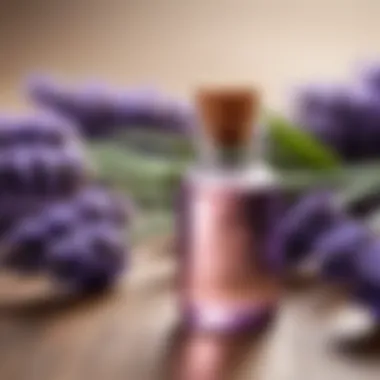
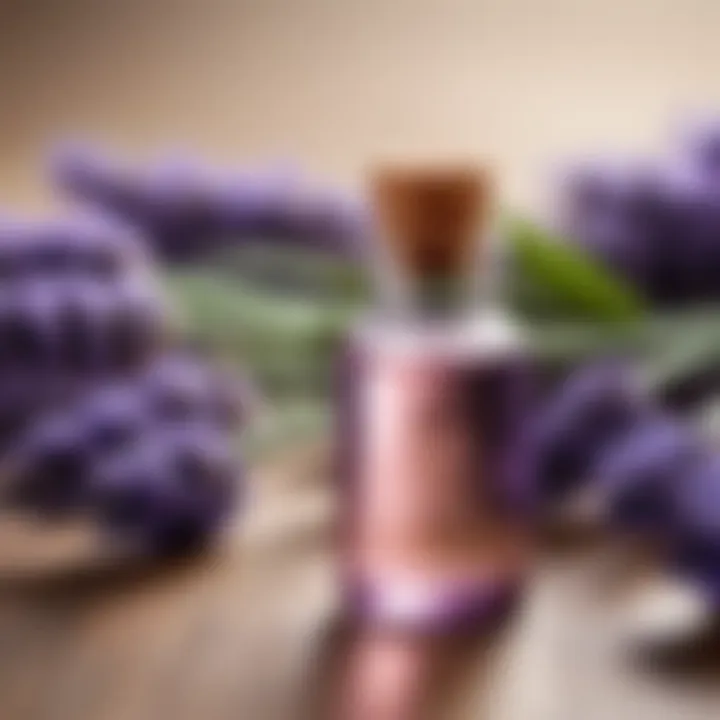
Spanish Lavender, known as Lavandula stoechas, is quite distinct with its butterfly-like flower tops. This type offers a slightly camphorous scent that some users find appealing for its invigorating qualities. Spanish Lavender is often used for its ability to enhance concentration and clarity, which may benefit mental health and productivity. However, its oil can be less versatile compared to English and French Lavender, and its unique scent might not resonate with everyone. Cultivation-wise, Spanish Lavender does well in dry, sandy soils but requires more attention to moisture levels than its counterparts.
Growing Conditions
The growing conditions of lavender are vital in determining its health and the potency of its essential oils. Generally, lavender thrives in well-drained, sandy or rocky soils and prefers full sunlight. It can tolerate droughts, making it suitable for those wanting a low-maintenance garden. However, overwatering is a quick ticket to disaster, leading to root rot.
"To cultivate healthy lavender, ensure it gets at least six hours of sunlight daily and never let its roots sit in wet soil."
When planted in suitable conditions, lavender not only flourishes but also produces flowers rich in essential oils. This richness directly correlates to the plant’s therapeutic and culinary uses, showcasing the importance of understanding its specific growth conditions.
In summary, the botanical characteristics of lavender—particularly its types and growing conditions—significantly affect its versatility and application across wellness domains. Choosing the right lavender for a specific need requires insights not just into the types available, but also how they grow and where they thrive.
Aromatherapy and Mental Health
Aromatherapy has gained traction as a holistic approach to mental well-being, and lavender plays a pivotal role in this practice. Known for its aromatic properties, lavender does more than just smell lovely; it offers numerous mental health benefits. Using lavender as a treatment in aromatherapy can assist in calming the mind, enhancing sleep, and reducing stress. Given the increasing pace of modern life, understanding these benefits can be particularly essential for achieving mental balance.
Calming Effects
Research suggests that the scent of lavender can reduce feelings of anxiety and restlessness. It's like a gentle lullaby for your senses, wrapping you in a blanket of peace. The main component of lavender, linalool, has been shown in studies to lower heart rate and blood pressure, creating a state of relaxation. Just imagine walking into a room filled with the soothing aroma of lavender essential oils; it’s as if the worries of the day simply drift away.
Moreover, incorporating lavender into a daily routine can enhance emotional resilience. A few drops of lavender oil in a diffuser or added to your bath can help set a calming atmosphere. This simple act can transform a regular space into a sanctuary, fostering an environment where mental peace can flourish. In essence, lavender becomes an ally for times when life feels a bit chaotic.
Sleep Enhancement
Sleeping well is key to overall health, and lavender has long been heralded for its sleep-promoting properties. The calming scent can act like a lullaby, nudging your mind toward restful sleep. Studies have shown that those who inhale lavender before bed often report deeper, more restorative sleep cycles. It’s almost like nature's own sleep aid.
To make use of lavender for sleep enhancement, consider placing a sachet of dried lavender under your pillow or using a lavender-infused pillow spray. This incorporation can subtly signal to your brain that it's time to unwind and let go of the day's stress. Furthermore, making a habit of blending a few drops of lavender essential oil into your bedtime routine may become a soothing ritual that beckons your mind toward sleep.
Stress Reduction Techniques
The pressures of daily life can pile up, leading to feelings of overwhelm. Lavender emerges as a trusted companion for stress relief. Techniques that incorporate lavender can range from breathing exercises to massages with lavender-infused oils. For instance, one simple method is the “4-7-8” breathing technique:
- Inhale deeply for 4 seconds, allowing your abdomen to expand.
- Hold your breath for 7 seconds while allowing the aroma of lavender to fill your senses.
- Exhale slowly for 8 seconds, letting go of tension with each breath.
This practice, combined with the calming scent of lavender, can create a powerful stress-reducing effect. It's a straightforward yet effective way to address anxiety, making this fragrant herb an essential part of any stress management toolkit.
In summary, aromatherapy with lavender offers substantial benefits for mental health. From calming the mind to enhancing sleep and reducing stress, lavender’s multifaceted properties place it at the forefront of natural well-being strategies. The gentle touch of this fragrant plant may just be what many need to nurture a balanced mental life.
"Lavender has historically been known as a natural remedy to soothe the mind and soothe the soul."
Integrating lavender into daily practices takes little effort yet yields profound effects on mental wellness. It's no wonder that this beloved herb continues to capture attention in the realm of mental health.
Skin Care Applications
Lavender's role in skin care applications is not just a trendy topic; it holds considerable importance for those seeking natural remedies for various skin issues. Lavender oil, derived from the lavender plant, is rich in antioxidants and possesses anti-inflammatory properties, making it a valuable addition to skincare routines. The gentle fragrance is an added bonus, often perceived as calming and soothing, which can enhance the overall experience of personal care. In the following sections, we will delve into three major skin care applications of lavender: its anti-aging properties, its ability to soothe skin irritations, and its effectiveness in treating acne.
Anti-Aging Properties
Anti-aging solutions are a high priority for many, and lavender oil shines in this regard. With its antioxidant characteristics, lavender oil effectively combats free radicals, which are notorious for accelerating the aging process. This can help in reducing the appearance of fine lines and wrinkles, making the skin look more youthful. Furthermore, lavender promotes circulation, which is essential for delivering nutrients to skin cells. As blood flow increases, one might notice a more vibrant and healthy complexion.
Another informative point is that lavender's calming scent can also help in reducing stress levels, which in itself is a antidote to premature aging. Stress often manifests on our skin and contributes to issues such as dullness. Using lavender-infused products, like face oils or cream, can provide a multi-layered approach to combatting aging.
"Lavender's rich antioxidant content may not only protect your skin but also offer a serene experience during your skincare routine."
Soothing Skin Irritations
Lavender oil's soothing attributes make it a popular choice for easing skin irritations. People often experience conditions such as eczema, psoriasis, or allergic reactions that can leave the skin red and itchy. Lavender boasts anti-inflammatory properties that can help calm these reactions. Additionally, its natural antiseptic qualities may protect the skin from further irritation and infections, allowing for quicker healing.
When using lavender for skin irritations, it’s crucial to integrate it thoughtfully. A person might dilute lavender essential oil with a carrier oil, such as coconut or jojoba oil, and apply it gently to the affected areas. This not only helps in addressing the irritation but also imparts moisture, thus enhancing skin hydration.
Acne Treatment
Acne is a common concern for many individuals, impacting both teens and adults alike. Lavender carries antibacterial properties that can aid in eliminating bacteria responsible for acne breakouts. By applying diluted lavender oil topically, users may find that their acne heals more efficiently and scarring is less visible.
Incorporating lavender into your skincare regimen for acne treatment isn’t rocket science but does require some mindfulness. By creating DIY facial masks with lavender-infused clay or using commercial products that list lavender oil among their ingredients, individuals can effectively target acne while nurturing their skin.
In summary, lavender’s numerous applications in skincare offer valuable, natural alternatives to synthetic products. From its anti-aging benefits to its ability to soothe irritations and combat acne, lavender stands out as an essential ingredient for maintaining healthy skin.
Health Benefits
Lavender is not just a pretty face in the world of flora; it’s a powerhouse of various health benefits that can touch every corner of our well-being. From soothing those pesky digestive issues to relieving the grip of pain, particularly headaches and muscle soreness, lavender’s charm extends well beyond its delightful aroma. This section seeks to uncover how lavender can be a practical ally in supporting health, offering both traditional and modern insights into its effectiveness.
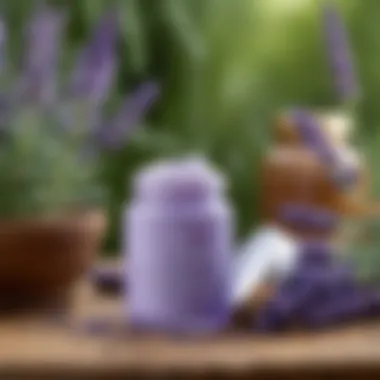

Digestive Aid
One of lavender's treasured benefits lies in its ability to assist the digestive system. Many folks have experienced the uncomfortable feeling of bloating or sluggish digestion after indulging in a heavy meal. Here, lavender can step in as a gentle hand, helping to soothe the gut and ease discomfort while promoting overall digestive health. Its calming properties can even help reduce stress, which often plays a role in digestive issues, making it a holistic choice for maintaining a happy gut.
"Lavender isn’t just about pleasing scents; it offers tangible benefits for digestion, paving the way for smoother bodily functions."
Pain Relief
Headaches
Headaches can be a real downer, can't they? The pounding in the temples and the constant distraction can make it hard to function. Lavender essential oil has been recognized for its pain-relieving properties, particularly for headaches. The unique fragrance has a calming effect, which often helps to ease tension headaches or stress-induced migraines. When used in aromatherapy or applied topically (with a carrier oil), it may provide a sense of relief that many seek with a more natural approach.
Students and professionals alike have found solace in its use. Imagine trying to meet a deadline with a throbbing headache – that’s where lavender shines as both an effective and popular choice for relief. Its key characteristic? The scent encourages relaxation, allowing the body to move from discomfort to a more balanced state.
Muscle Pain
Muscle pain, often caused by overexertion or tension, is another area where lavender proves its worth. After a long day of physical activity, many individuals turn to muscle rubs or soak in a tub infused with lavender essence to find relief. What makes lavender stand out is not just the relief but its unique ability to promote relaxation alongside pain reduction. This dual effect means that while easing muscle tension, it also calms the mind, providing a comprehensive approach to recovery the body deserves.
The comforting aroma combined with its anti-inflammatory properties makes it a go-to for many seeking relief after a hard workout or a stressful week. Its attraction lies in the natural approach to pain relief, sidestepping the need for heavy medications.
Respiratory Support
Lastly, who hasn’t experienced a cough or an allergy flare-up at the worst possible moment? Lavender can play a supportive role in respiratory health as well. Known for its soothing and calming effects when inhaled, lavender can help to alleviate the symptoms of colds, allergies, and other respiratory ailments. Its expectorant properties might help clear mucus and relieve congestion.
For those who often find themselves grappling with these issues, incorporating lavender through steam inhalation or as part of a humidifier can be a breath of fresh air. It’s a gentle supporter of respiratory function, making it a valuable addition to health regimens aimed at maintaining respiratory wellness.
In summary, the health benefits of lavender extend far and wide, touching upon digestive aid, pain relief, and respiratory support that cater to everyday issues faced by many. With its easy accessibility and natural approach, it becomes an attractive option for anyone keen to step softly into a healthier life.
Usage and Application Methods
When we explore the expansive benefits of lavender, it is essential to discuss how it’s used and applied. Understanding these methods not only emphasizes its versatility but also encourages individuals to seamlessly integrate its benefits into their daily routines. Lavender’s exceptional properties, rooted in its rich chemical profile, can be harnessed in multiple forms, each serving diverse needs and preferences. From essential oils to infused products, knowing the nuances of these applications enhances the efficacy of lavender in promoting well-being.
Essential Oils
Lavender essential oil stands at the forefront of its applications, brimming with therapeutic benefits. Extracted from the flowering tops of the lavender plant, this oil showcases a high concentration of the plant’s healing compounds. Its calming aroma makes it a staple in aromatherapy, providing a simple yet effective means to alleviate stress and promote relaxation. Beyond its soothing scent, lavender oil is widely regarded for its soothing properties on the skin, acting as a natural remedy for minor burns and sunburns.
Additionally, one notable feature of lavender essential oil is its broad compatibility with other essential oils. This turn-out allows users to blend it with citrus or woodsy oils, creating a tailored aromatherapy experience. However, a point to consider is that it can cause skin irritation in some individuals, so it’s prudent to conduct a patch test.
Lavender Infused Products
Oils
Lavender-infused oils represent another popular application method, often utilized for their nourishing properties. These oils are generally made by merging carrier oils, like jojoba or sweet almond oil, with lavender extracts. The key characteristic of these oils is their multifunctionality; they can be used for massage, skin care, or even hair treatment. The rich scent not only enhances the experience but also contributes to the oil’s relaxing qualities.
That being said, the quality of the carrier oil is crucial. Cheaper brands may dilute the benefits of lavender, bringing forth the importance of selecting products from reputable sources. The infused oils often carry a lighter scent than pure lavender oil, which might suit individuals seeking subtler aromatic profiles.
Lotions
When it comes to lotions, lavender-infused products are favored for their ability to hydrate while also providing therapeutic benefits. These lotions help to calm the skin and are often sought after by those with sensitive skin conditions. They typically include ingredients like shea butter and aloe vera, reinforcing the lotion's soothing properties.
One unique aspect is the combination of hydration and aromatherapy, giving users a dual experience of skin care and mental tranquility. However, it’s important to note that not all lotions are created equal; some may include artificial fragrances that dilute the natural benefits of lavender. A careful read of ingredient labels helps ensure users select quality products, maximizing the favorable effects of lavender.
Bath Salts
Lavender bath salts are yet another exceptional way to harness the plant's calming essence. Bathing in warm water infused with lavender salts transforms an ordinary soak into a relaxing ritual, promoting both physical and mental well-being. The key characteristic of these salts lies in their ability to melt away stress and tension, providing a momentary escape from life’s chaos.
Moreover, the salts can be enriched with Epsom salt, delivering muscle relief while enveloping you in a soothing lavender aroma. While they’re often well-received for their benefits, care must be taken to avoid overuse, as frequent hot baths can lead to dehydrated skin. This subtle balance underscores the importance of moderation when indulging in lavender-infused bathing experiences.
"Incorporating lavender into daily routines can enhance the overall wellness experience, offering moments of peace amidst a busy life."
In summary, the various methods of using and applying lavender are crucial to understanding its benefits. Each application, whether oil, lotion, or bath salts, presents a unique way to engage with the plant’s restorative properties. As individuals explore these options, they can find their own ideal method of incorporating lavender into their day-to-day lives.
Culinary Uses of Lavender
The culinary application of lavender reveals yet another facet of this astonishing plant. Traditionally perceived as a mere ornamental flower, lavender’s versatility reaches into the heart of the kitchen. Its distinct aroma not only awakens the senses but also harmonizes flavors, contributing to present-day culinary artistry. Thus, understanding how to leverage lavender in cooking opens a treasure chest of possibilities, including both flavor enhancement and health benefits.
Flavoring Agent
Lavender acts as a unique flavoring agent, infusing dishes with its aromatic, slightly floral notes. Instead of being just an afterthought, this ingredient can significantly modify the flavor profile of meals. In small doses, it can elevate sweet desserts or balance savory elements, allowing chefs to engage diners' palates on several levels.
Key Characteristics:
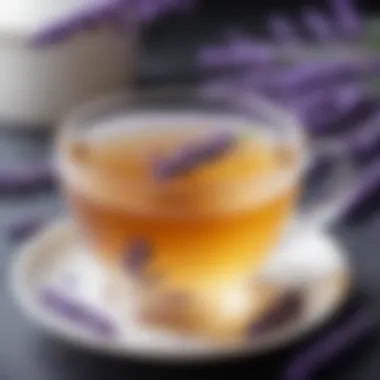
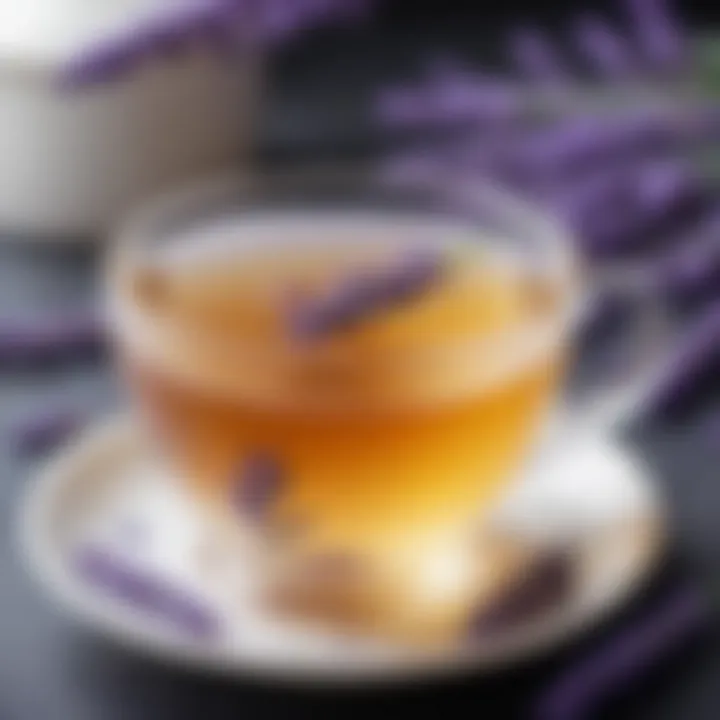
- Aroma and Taste: The flavor profile is best described as sweet and slightly herbaceous, which pairs beautifully with a variety of ingredients, ranging from honey to lemon.
- Versatility: It's not limited to sweet dishes; lavender can add depth to savory meals as well.
One consideration to keep in mind when using lavender in cooking is its potency. A little goes a long way, and using too much can overwhelm the dish, leading to an unpleasant dining experience. Therefore, culinary experts recommend starting with a small amount and adjusting according to personal taste preferences.
Lavender in Cooking
Desserts
Lavender has found its niche in dessert preparations. Its delicate flavor can transform ordinary recipes into gourmet delights. For instance, lavender-infused cookies or cupcakes bring a subtle sophistication to traditional baked goods.
Contribution to Overall Topic:
- Flavor Enhancement: When combined with vanilla or citrus, lavender can create a refreshing complexity, making desserts memorable.
- Health Benefits: Including lavender in desserts may also introduce its calming properties, which ties back to the overall wellness narrative of this article.
Unique Features:
- Color and Aroma: It brings a visual appeal and a captivating aroma that enhances the whole eating experience.
- Culinary Creativity: Lavender enables culinary players to think outside the box, offering a creative avenue that challenges the status quo of flavor profiles.
However, one must navigate its unique flavor carefully; the balance can be easily tipped, leading to desserts that may taste like potpourri if not used judiciously.
Savory Dishes
Lavender isn’t just for sweets. In savory dishes, its potential shines equally bright. Adding lavender to marinades or roasted meats provides a delightful contrast to earthy flavors. It works exceptionally well in Mediterranean dishes, especially when paired with lamb or poultry.
Contribution to Overall Topic:
- Flavor Complexity: Lavender composes a melody of flavors that can harmonize with garlic, rosemary, and thyme, often resulting in dishes that sing of summer herbs.
- Cultural Significance: This use of lavender reflects its roots in Mediterranean cuisine, reinforcing the cultural layers discussed earlier in this article.
Unique Features:
- Aromatic Depth: Similar to other herbs, its aroma can enrich the cooking process, as it releases essential oils during cooking, enhancing the dish's overall profile.
- Health Considerations: Lavender is known for its digestive benefits, so incorporating it into food may indeed serve a dual purpose; taste and health, thereby aligning perfectly with the wellness theme.
Precautions and Considerations
When considering the multitude of benefits lavender offers, it is equally vital to be mindful of the precautions and considerations surrounding its use. All good things, as the saying goes, must come with a measure of caution. While lavender is praised for its calming properties and various applications in wellness, an understanding of its potential downsides ensures its integration into daily life is both safe and effective. This section sheds light on allergic reactions and the nuances of dosage recommendations, equipping you with essential knowledge to make informed choices.
Allergic Reactions
Even the gentlest of remedies can cause unexpected sensitivities. Lavender, while largely considered safe, isn't immune to provoking allergic reactions in some individuals. This could manifest as skin irritations or respiratory issues. For example, someone with asthma may find that the scent triggers their symptoms, while another might develop rashes upon contact with lavender-infused products.
Important points to consider include:
- Patch Test: Before slathering lavender lotion all over, apply a small amount to a discreet area of skin. Wait 24 hours to check for any adverse reaction.
- Respiratory Caution: If you have a history of allergies or asthma, try using lavender essential oil in a diffuser rather than direct inhalation.
- Know Your Sources: Ensure the lavender products you use are pure and free from additives that could trigger an allergic response.
"Better safe than sorry. A little caution goes a long way in preserving your health!"
Recognizing your own body’s limits can be the difference between a soothing experience and a problematic one.
Dosage Recommendations
Navigating the world of dosage can often feel like walking on a tightrope. Finding the right balance is key to harnessing lavender's benefits without inviting potential side effects. Given that different forms of lavender exist—be it essential oils, teas, or infused lotions—it's crucial to tailor your dosage to the specific method of use. Here’s a breakdown for a few popular forms of lavender:
- Essential Oils: For diffusing, around 3-5 drops in a standard diffuser is adequate. If applying on skin, always dilute with a carrier oil, using a ratio of no more than 1:4 (one part essential oil to four parts carrier).
- Lavender Tea: A general recommendation is 1-2 tsp of dried lavender flowers steeped in hot water for about 10 minutes. Adjust to personal taste, but more than this could lead to stomach upset.
- Lavender Pillows or Sachets: Stuffing a small pillow (about ½ cup of dried flowers) is enough to infuse a noticeable scent in your space without overwhelming the senses.
Always consult with a healthcare provider if unsure about the appropriate dosage, especially for pregnant or breastfeeding women and individuals with existing health conditions. Keep in mind that more is not always merrier—too much lavender can lead to discomfort or adverse effects.
Understanding these precautions can empower you to enjoy the myriad benefits of lavender with greater confidence and safety. Lavender may be nature’s calming gift, but like any work of nature, it flourishes best with a touch of respect.
Ending: The Enduring Appeal of Lavender
Lavender, often celebrated for its captivating aroma and soothing qualities, transcends mere fragrance; it stands as a testament to nature's ability to enhance our well-being. In this article, we have explored the diverse benefits of lavender, illuminating its multifaceted roles in aromatherapy, skincare, and health remedies. The enduring appeal of lavender lies not only in its pleasant scent but also in its effectiveness across various domains.
The importance of this topic cannot be overstated. As individuals increasingly seek natural remedies and holistic approaches to health, lavender emerges as a star player. Its calming effects have been documented in numerous studies, establishing it as a staple in mental health care. Furthermore, with skincare applications such as anti-aging and soothing properties, it is becoming a go-to ingredient in beauty routines.
Yet, while lavender offers many advantages, it is crucial to approach its use with a degree of caution. As discussed earlier in the Precautions and Considerations section, allergic reactions and dosage guidelines should not be overlooked. Only through a careful application can one truly benefit from lavender's offerings.
Future Research Directions
Continued investigation into the efficacy of lavender presents exciting possibilities. Current studies are beginning to uncover the nuanced ways lavender interacts with various physiological processes. Future research could focus on areas like:
- Effects on Mental Health: Exploring the impact of lavender on anxiety disorders and depression.
- Synergistic Effects: Understanding how lavender may enhance the effects of other natural remedies.
- Expanded Applications in Medicine: Investigating potential uses in pain management and chronic illness.
There is much to learn, and as science uncovers more about this plant, its reputation may swell even further.
Integrating Lavender into Everyday Life
Incorporating lavender into daily practices can be both pleasurable and beneficial. Here are some key ways to seamlessly blend lavender into your life:
- Aromatherapy: Whether it’s through diffusers or lavender sachets, integrating lavender into your home can create a tranquil environment.
- Skincare Regimen: Look for products containing lavender oil or extract. Adding a lavender-infused lotion after showers can enhance your skincare routine.
- Culinary Adventures: Consider using dried lavender in cooking. It adds a unique touch to desserts or even savory dishes. Just remember, a little goes a long way!







